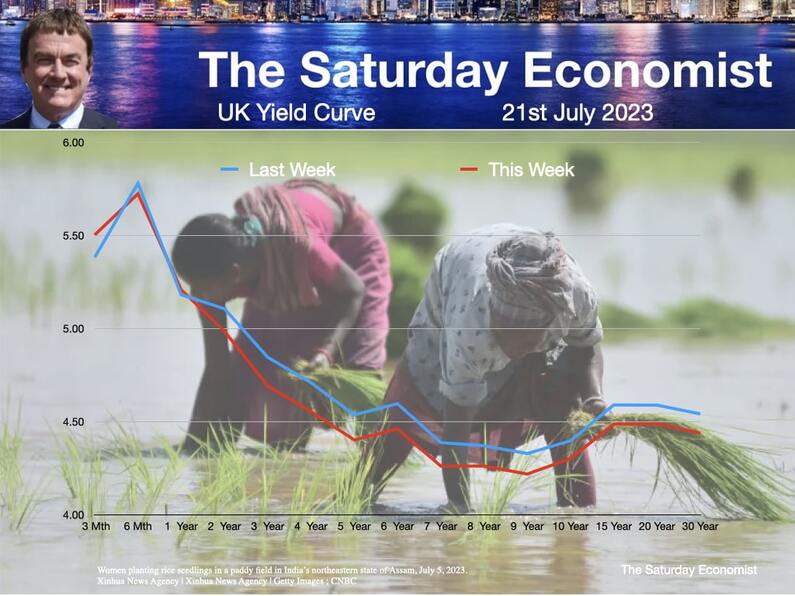|
Inflation ...
CPI eased to 7.9% in June from 8.7% in May. Core inflation, eased to 7.1% from 6.9%. Inflation remains “sticky”. Energy costs increased by 23.3%. Food inflation increased at over 17%. Service sector inflation eased to 7.2%. Goods inflation slowed to 8.5% from 9.7%. Producer Prices are moving in the right direction. Input prices fell to -1.9% in June from 1.6% in May. Output prices moved to 0.1% from 2.7% prior month. US inflation peaked in June last year. Inflation in the UK peaked in October. US CPI has fallen to 3% from the 9% peak. Pessimists may be impatient with progress. We expect input and output prices to be negative in Q3 and Q4. Headline consumer price inflation will drop below 5% in the final quarter of the year. Markets and the MPC have been spooked by the latest data on inflation and earnings. Earnings increased by 7.4% in May. The government has said it accepts in full recommended public pay rises of 5 - 7% for police, teachers and doctors. The latest guarantees on public sector pay will continue to alarm the hawks. The latest trends in international food markets will do nothing to ease fears of higher prices. Black Sea Blackmail … The Kremlin said earlier this week that it would pull out of the international agreement that allowed Ukraine to resume its grain exports through the Black Sea. Russia’s withdrawal from a deal that had kept Ukrainian grain flowing to world markets has sent prices soaring in recent days. A main beneficiary of the surge is Russia itself. Wheat futures in Chicago have climbed 12% this week so far, rising to the highest level since June 23. Futures tied to corn are up 9.3%. Rice Prices Rising ... India’s rice export ban could send decade-high prices spiking even further. India has banned the exports of non-basmati white rice with immediate effect. India is the world’s leading rice exporter, accounting for more than 40% of the global rice trade. Analysts told CNBC this week’s ban could send already elevated prices shooting even higher, compounding effects from the country’s September ban on shipments of broken rice. So what next for rates ... Financial markets reacted positively to the inflation news. There was a sharp drop in swap rates. Two-year swap rate dropped from 5.93 per cent on Monday to 5.46 per cent on Wednesday. Forecasts for peak interest rates dropped from 6% to 5.75%. There was little reaction along the gilt curve. Ten basis points the average fall over the duration. Three month gilts trade at 5.5% from 5.4%. Six month gilt yields trade at 5.7% from 5.8%. UK two years offer 5.0% down from 5.1%. UK ten year gilt yields are trading at 4.30% from 4.40%. UK 30 year rates are at 4.44% from 4.54%. Lower mortgage rates are in prospect. Short term rates remain over priced. No real price adjustment, the immediate reaction. We maintain our base rate peak this year at 5.5% on the basis of two 25 basis point hikes in August and September. We model 4.50% as the long run rate for base rates and ten year gilts in life after Planet ZIRP.* * Long Term Note : In the UK, prior to the Great Financial Crash [2000 - 2008] the average inflation rate was 2.0%, the average UK bank rate was 4.50%. Ten year bond yields averaged 4.50%. Friday Forward Guidance Every Week ... This is a section from our Friday Forward Guidance for Friday 21st July. Every week we update our scenario forecasts for base rates in the U.S., UK and Europe over a three year period. We also include our expectations for inflation, as an input to the central bank reaction function, in the Saturday Economist updates.
0 Comments
Leave a Reply. |
The Saturday EconomistAuthorJohn Ashcroft publishes the Saturday Economist. Join the mailing list for updates on the UK and World Economy. Archives
July 2024
Categories
All
|
| The Saturday Economist |
The material is based upon information which we consider to be reliable but we do not represent that it is accurate or complete and it should not be relied upon as such. We accept no liability for errors, or omissions of opinion or fact. In particular, no reliance should be placed on the comments on trends in financial markets. The presentation should not be construed as the giving of investment advice.
|
The Saturday Economist, weekly updates on the UK economy.
Sign Up Now! Stay Up To Date! | Privacy Policy | Terms and Conditions | |

 RSS Feed
RSS Feed